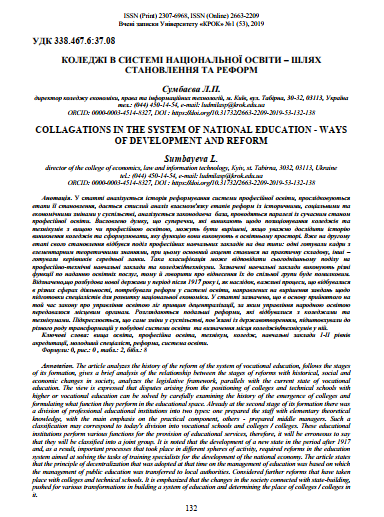COLLAGATIONS IN THE SYSTEM OF NATIONAL EDUCATION - WAYS OF DEVELOPMENT AND REFORM
DOI:
https://doi.org/10.31732/2663-2209-2019-53-132-138Keywords:
higher education, vocational education, technical school, college, educational institutions of І-ІІ levels of accreditation, junior specialist, reform, education systemAbstract
The article analyzes the history of the reform of the system of vocational education, follows the stages of its formation, gives a brief analysis of the relationship between the stages of reforms with historical, social and economic changes in society, analyzes the legislative framework, parallels with the current state of vocational education. The view is expressed that disputes arising from the positioning of colleges and technical schools with higher or vocational education can be solved by carefully examining the history of the emergence of colleges and formulating what function they perform in the educational space. Already at the second stage of its formation there was a division of professional educational institutions into two types: one prepared the staff with elementary theoretical knowledge, with the main emphasis on the practical component, others - prepared middle managers. Such a classification may correspond to today's division into vocational schools and colleges / colleges. These educational institutions perform various functions for the provision of educational services, therefore, it will be erroneous to say that they will be classified into a joint group. It is noted that the development of a new state in the period after 1917 and, as a result, important processes that took place in different spheres of activity, required reforms in the education system aimed at solving the tasks of training specialists for the development of the national economy. The article states that the principle of decentralization that was adopted at that time on the management of education was based on which the management of public education was transferred to local authorities. Considered further reforms that have taken place with colleges and technical schools. It is emphasized that the changes in the society connected with state-building, pushed for various transformations in building a system of education and determining the place of colleges / colleges in it.
Downloads
References
Про освіту : Закон України. Редакція від 23.05.1991. URL : http://zakon3.rada.gov.ua/laws/show/1060-12/ed19910523.
Про освіту : Закон України. Редакція від 06.09.2014. URL : http://zakon3.rada.gov.ua/laws/show/1060-12/ed20140906.
Про вищу освіту : Закон України. Редакція від 01.07.2014. URL : https://zakon5.rada.gov.ua/laws/show/1556-18.
Анісімов М. Історичні передумови становлення і ровитку професійної системи освіти (початок XVIII – перша половина XIX ст.). Наукові записки Кіровоградського державного педагогічного університету імені Володимира Винниченка. Серія: Проблеми методики фізико-математичної і технологічної освіти). 2013. Вип. 4 (1). C. 278-282.
Про народну освіту : Закон Української Радянської Соціалістичної Республіки. Редакція від 28червня 1974 року. URL : http://search.ligazakon.ua/l_doc2.nsf/link1/T742778.html.
Кузьменко М. Система освіти в УСРР у 1920-их р. p. : історико-теоретичний аспек. Український історичний журнал. 2004. № 5. С. 66-80.
Купрійчук В. Розвиток освітніх процесів у період Української національної революції 1917-1920 років. Збірник наукових праць Національної академії державного управління при Президентові України. 2011. Вип. 2. С. 237-245.
Шемшученко Ю. С. Юридична енциклопедія : в 6 т. Українська енциклопедія ім. М.П. Бажана. 2004. Т.6. URL : leksika.com.ua/13190713/legal/koledzh/.


